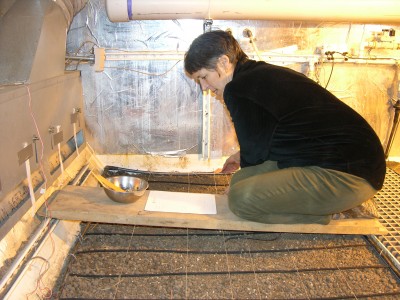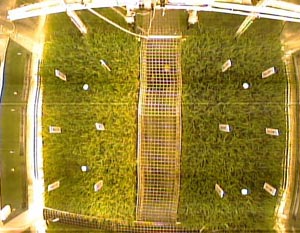Second Experiment: Dwarf Wheat
 The plants were planted at two density levels: 356 seeds per m2 and 746 seeds per m2. Light levels were on average 48.4 mol m-2 d-1 Almost three months later, between the 16th and 18th of May, 2003 the east and west-side soil-beds were harvested in planned sequence and the plants cut off at ground level. On the east side the dry seed biomass was 566.5 g m-2 and on the west side the dry seed biomass was 812.3 g m-2. The overall yield was slightly lower (5-10%) compared with KSC Breadboard wheat crops grown with a hydroponic solution, but with comparable light levels which shows the importance of testing space-based cultivars with soil-based systems as a sustainable system. Though the wheat cultivar experiment had reached a successful conclusion, system monitoring and facility testing continued for some time afterwards. The addition of a downward looking digital camera allows system operators to see from a fixed vantage point, events occurring inside the chamber, in real time. Until now observations had relied upon observation of the inside of the chamber either through the viewing windows, or by direct observation at times when a crew-member entered the Chamber to carry out necessary maintenance, weeding etc. The camera is programmed to take a fixed number of images throughout the day, which can then be correlated with other data. Eventually remote image analysis, both quantitative and qualitative, will be carried out using this and later upgrade versions of the system.
The plants were planted at two density levels: 356 seeds per m2 and 746 seeds per m2. Light levels were on average 48.4 mol m-2 d-1 Almost three months later, between the 16th and 18th of May, 2003 the east and west-side soil-beds were harvested in planned sequence and the plants cut off at ground level. On the east side the dry seed biomass was 566.5 g m-2 and on the west side the dry seed biomass was 812.3 g m-2. The overall yield was slightly lower (5-10%) compared with KSC Breadboard wheat crops grown with a hydroponic solution, but with comparable light levels which shows the importance of testing space-based cultivars with soil-based systems as a sustainable system. Though the wheat cultivar experiment had reached a successful conclusion, system monitoring and facility testing continued for some time afterwards. The addition of a downward looking digital camera allows system operators to see from a fixed vantage point, events occurring inside the chamber, in real time. Until now observations had relied upon observation of the inside of the chamber either through the viewing windows, or by direct observation at times when a crew-member entered the Chamber to carry out necessary maintenance, weeding etc. The camera is programmed to take a fixed number of images throughout the day, which can then be correlated with other data. Eventually remote image analysis, both quantitative and qualitative, will be carried out using this and later upgrade versions of the system.
Below is a slider from the before and after image of the growing wheat. White objects represent a variety of plot markers and sensor points. Later image shows the dwarf wheat ripening to maturity. This image was taken a few weeks prior to harvest.
Reference 1:
William F. Dempster, J.P. Allen, A. Alling , M. Nelson, S. Silverstone, M. Van Thillo. 2003. Atmospheric dynamics in the Laboratory Biosphere with wheat and sweet potato crops. Advances in Space Research 2005;35(9):1552-6.
Abstract: Laboratory Biosphere is a 40 m3 closed life system equipped with 12000 watts of high pressure sodium lamps over planting beds with 5.37 m2 of soil. Atmospheric composition changes due to photosynthetic fixation of carbon dioxide and corresponding production of oxygen or the reverse, respiration, are observed in short timeframes, e.g. hourly. To focus on inherent characteristics of the crop as distinct from its area or the volume of the chamber, we report fixation and respiration rates in mmol h-1 m-2 of planted area. An 85 day crop of USU Apogee wheat under a 16 hour lighted / 8 hour dark regime peaked in fixation rate at about 100 mmol h-1 m-2 approximately 24 days after planting. Light intensity was about 840 mmol m-2 s-1. Dark respiration peaked at about 31 mmol h-1 m-2 at the same time. Thereafter, both fixation and respiration declined toward zero as harvest time approached. A residual soil respiration rate of about 1.9 mmol h-1 m-2 was observed in the dark closed chamber for 100 days after the harvest. A 126 day crop of Tuskegee TU-82-155 sweet potato behaved quite differently. Under a 680 m mol m-2s-1, 18 hour lighted / 6 hour dark regime, fixation during lighted hours rose to a plateau ranging from about 27 to 48 mmol h-1 m-2 after 42 days and dark respiration settled into a range of 12 to 23 mmol h-1 m-2. These rates continued unabated until the harvest at 126 days, suggesting that tuber biomass production might have continued at about the same rate for some time beyond the harvest time that was exercised in this experiment. In both experiments CO2 levels were allowed to range widely from a few hundred ppm to about 3000 ppm, which permitted observation of fixation rates both at varying CO2 concentrations and at each number of days after planting. This enables plotting the fixation rate as a function of both variables. Understanding the atmospheric dynamics of individual crops will be essential for design and atmospheric management of more complex CELSS which integrate the simultaneous growth of several crops as in a sustainable remote life support system. © 2005 COSPAR
Reference 2:
Nelson, M., W.F. Dempster, S. Silverstone, A. Alling, J.P. Allen and M. Van Thillo. 2005. Crop yield and light/energy efficiency in a closed ecological system: two laboratory biosphere experiments. Advances in Space Research 35 (2005) 1539-1543.
Abstract: Two crop growth experiments in the soil-based closed ecological facility, Laboratory Biosphere, were conducted from 2003 to 2004 with candidate space life support crops. Apogee wheat (Utah State University variety) was grown, planted at two densities, 400 and 800 seeds m-2. The lighting regime for the wheat crop was 16 h of light-8 h dark at a total light intensity of around 840 micromoles m-2 s-1 and 48.4 mol m-2 d-1 over 84 days. Average biomass was 1395 g m-2, 16.0 g m-2 d-1 and average seed production was 689 g m-2 and 7.9 g m-2 d-1. The less densely planted side was more productive than the denser planting, with 1634 g m-2 and 18.8 g m-2 d-1 of biomass vs. 1156 g m-2 and 13.3 g m-2 d-1; and a seed harvest of 812.3 g m-2 and 9.3 g m-2 d-1 vs. 566.5 g m-2 and 6.5 g m-2 d-1. Harvest index was 0.49 for the wheat crop. The experiment with sweet potato used TU-82-155 a compact variety developed at Tuskegee University. Light during the sweet potato experiment, on a 18 h on/6 h dark cycle, totaled 5568 total moles of light per square meter in 126 days for the sweet potatoes, or an average of 44.2 mol m-2 d-1. Temperature regime was 28 +/- 3 degrees C day/22 +/- 4 degrees C night. Sweet potato tuber yield was 39.7 kg wet weight, or an average of 7.4 kg m-2, and 7.7 kg dry weight of tubers since dry weight was about 18.6% wet weight. Average per day production was 58.7 g m-2 d-1 wet weight and 11.3 g m-2 d-1. For the wheat, average light efficiency was 0.34 g biomass per mole, and 0.17 g seed per mole. The best area of wheat had an efficiency of light utilization of 0.51 g biomass per mole and 0.22 g seed per mole. For the sweet potato crop, light efficiency per tuber wet weight was 1.33 g mol-1 and 0.34 g dry weight of tuber per mole of light. The best area of tuber production had 1.77 g mol-1 wet weight and 0.34 g mol-1 of light dry weight. The Laboratory Biosphere experiment’s light efficiency was somewhat higher than the USU field results but somewhat below greenhouse trials at comparable light levels, and the best portion of the crop at 0.22 g mol-1 was in-between those values. Sweet potato production was overall close to 50% higher than trials using hydroponic methods with TU-82-155 at NASA JSC. Compared to projected yields for the Mars on Earth life support system, these wheat yields were about 15% higher, and the sweet potato yields averaged over 80% higher.


